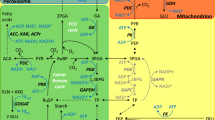Abstract
The aim of this work was to investigate the partitioning of imported glucose 6-phosphate (Glc6P) to starch and fatty acids, and to CO2 via the oxidative pentose phosphate pathway (OPPP) in plastids isolated from developing embryos of oilseed rape (Brassica napus L.). The ability of the isolated plastids to utilize concurrently supplied substrates and the effects of these substrate combinations on the Glc6P partitioning were also assessed. The relative fluxes of carbon from Glc6P to starch, fatty acids, and to CO2 via the OPPP were close to 2∶1∶1 when Glc6P was supplied alone. Under these conditions NADPH generated via the OPPP was greater than that required by the concurrent rate of fatty acid synthesis. Fatty acid synthesis was unaffected by the presence or absence of exogenous NADH and/or NADPH and the requirement of fatty acid synthesis for reducing power is therefore met entirely by intraplastidial metabolism. When Glc6P was supplied in the presence of either pyruvate or pyruvate and acetate, the total flux from these metabolites to fatty acids was up to threefold greater than that from either Glc6P or pyruvate when they were supplied singly. In these experiments there was little competition between Glc6P and pyruvate in fatty acid synthesis and the flux to starch was unchanged. This implies that the starch and fatty acid biosynthesis pathways did not compete for the exogenously supplied ATP on which they were strongly dependent. When Glc6P and pyruvate were provided together, the NADPH generated by the OPPP pathway was less than that required by the concurrent rate of fatty acid synthesis. This suggests that the metabolism of exogenous Glc6P via the OPPP can contribute to the NADPH demand created during fatty acid synthesis but it also indicates that other intraplastidial sources of reducing power must be available under the in-vitro conditions used.
Similar content being viewed by others
Abbreviations
- GAPDH:
-
glyceraldehyde-3-phosphate dehydrogenase
- Glc6P:
-
glucose-6-phosphate
- OPPP:
-
oxidative pentose phosphate pathway
- PIM:
-
plastid isolation medium
- Pyr:
-
pyruvate
References
Borchert S, Harborth J, Schünemann D, Hoferichter P, Heldt HW (1993) Studies of the enzymic capacities and transport properties of pea root plastids. Plant Physiol 101: 303–312
Bowsher CG, Boulton EL, Rose J, Nayagam S, Emes MJ (1992) Reductant for glutamate synthase is generated by the oxidative pentose phosphate pathway in non-photosynthetic root plastids. Plant J 2: 893–898
Browse J, Slack CR (1985) Fatty-acid synthesis in plastids from maturing safflower and linseed cotyledons. Planta 166: 74–80
Coates SA, ap Rees T (1993) Carbohydrate oxidation by leucoplasts from suspension cultures of soybean (Glycine max L.). Planta 189: 516–521
Foster JM, Smith AM (1993) Metabolism of glucose-6-phosphate by plastids from developing pea embryos. Planta 190: 17–24
Fuhrmann J, Johnen T, Heise K-P (1994) Compartmentation of fatty acid metabolism in zygotic rape embryos. J Plant Physiol 143: 565–569
Harwood JL (1988) Fatty acid metabolism. Anun Rev Plant Physiol Plant Mol Biol 39: 101–138
Journet E-P, Douce R (1985) Enzymic capacities of purified cauliflower bud plastids for lipid synthesis and carbohydrate metabolism. Plant Physiol 79: 458–467
Kang F (1995) Carbon sources for starch and fatty acid synthesis in plastids from developing embryos of oilseed rape. PhD thesis, University of East Anglia, UK
Kang F, Rawsthorne S (1994) Starch and fatty acid synthesis in plastids from developing embryos of oilseed rape (Brassica napus L.). Plant J 6: 795–805
Kang F, Ridout CJ, Morgan CL, Rawsthorne S (1994) The activity of acetyl-CoA carboxylase is not correlated with the rate of lipid synthesis during development of oilseed rape (Brassica napus L.) embryos. Planta 193: 320–325
Kleppinger-Sparace KF, Stahl R, Sparace SA (1992) Energy requirements for fatty acid and glycerolipid biosynthesis from acetate by isolated pea root plastids. Plant Physiol 98: 723–727
Möhlmann T, Scheibe R, Neuhaus HE (1994) Interaction between fatty-acid and starch synthesis in isolated amyloplasts from cauliflower floral buds. Planta 194: 492–497
Mudd JB, Dezacks R (1981) Synthesis of phosphatidylglycerol by chloroplasts from leaves of Spinacia oleracea L. (spinach). Arch Biochem Biophys 209: 584–591
Qi Q, Kleppinger KF, Sparace SA (1995) The utilization of glycolytic intermediates as precursors for fatty acid biosynthesis by pea root plastids. Plant Physiol 107: 413–419
Reid EE, Thompson P, Lyttle CR, Dennis DT (1977) Pyruvate dehydrogenase complex from higher plant mitochondria and proplastids. Plant Physiol 59: 842–848
Smith RG, Gauthier DA, Dennis DT, Turpin DH (1992) Malate- and pyruvate-dependent fatty acid synthesis in leucoplasts from developing castor endosperm. Plant Physiol 98: 1233–1238
Williams M, Randall DD (1979) Pyruvate dehydrogenase complex from chloroplasts of Pisum sativum L. Plant Physiol 64: 1099–1103
Author information
Authors and Affiliations
Additional information
The authors are grateful to Drs A.M. Smith and K. Denyer for helpful and stimulating discussions throughout this study. We thank Drs D.J. Murphy and M.J. Hills for comments on the manuscript. Mrs S. Fincham is also thanked for glasshouse assistance. Seed of B. napus cv. Topas was kindly provided by Dalgety Agriculture (Essex, UK). This work was supported by the Biotechnology and Biological Sciences Research Council through grant-in-aid to the John Innes Centre and by a Cambridge Laboratory studentship to Fan Kang.
Rights and permissions
About this article
Cite this article
Kang, F., Rawsthorne, S. Metabolism of glucose-6-phosphate and utilization of multiple metabolites for fatty acid synthesis by plastids from developing oilseed rape embryos. Planta 199, 321–327 (1996). https://doi.org/10.1007/BF00196575
Received:
Accepted:
Issue Date:
DOI: https://doi.org/10.1007/BF00196575




